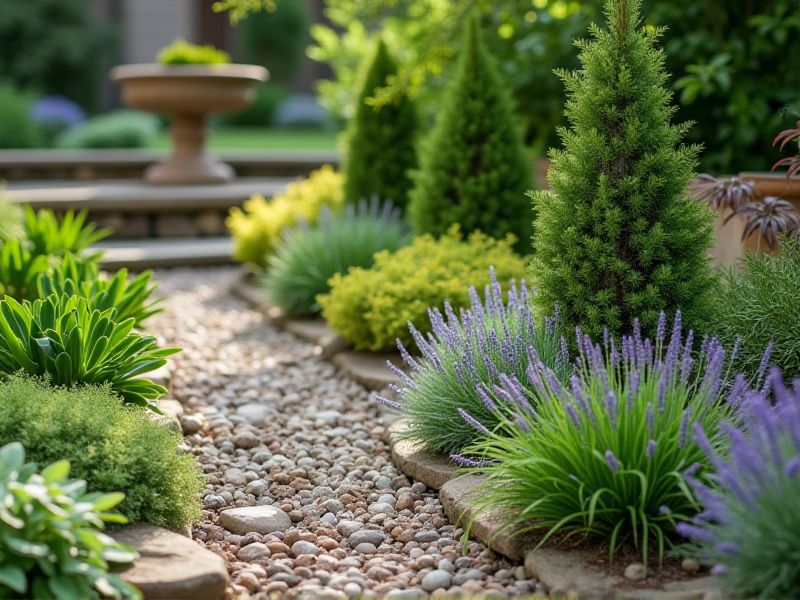
Rock garden plants that are compact are ideal for creating a picturesque landscape. Sedum, often known as stonecrop, features succulent foliage and a variety of colors, thriving in well-drained soil. The alpine perennial, Dianthus, offers fragrant blooms and low-growing habits, making it perfect for borders or crevices. Another excellent choice is the creeping thyme, which not only adds greenery but also releases a pleasant aroma when stepped upon. When selecting compact rock garden plants, consider the specific sunlight and watering needs to ensure optimal growth and vibrancy.
List of some Rock garden plants that are compact
- Creeping Thyme (Thymus serpyllum)
- Sea Thrift (Armeria maritima)
- Rockcress (Aubrieta deltoidea)
- Stonecrop (Sedum spp.)
- Snow-in-Summer (Cerastium tomentosum)
- Moss Phlox (Phlox subulata)
- Dwarf Iris (Iris reticulata)
- Blue Fescue (Festuca glauca)
- Bearberry (Arctostaphylos uva-ursi)
- Pasque Flower (Pulsatilla vulgaris)
Important things about Rock garden plants that are compact
Drought Resistance
Rock garden plants that show exceptional drought resistance include varieties like sedums, sempervivums, and alpine asters. These compact plants thrive in well-drained soils and require minimal water, making them ideal for xeriscaping and low-maintenance gardens. With their unique textures and vibrant colors, they contribute to a visually appealing landscape while conserving water resources. When selecting rock garden plants, consider native species, as they are typically well-adapted to local climate conditions, ensuring resilience against drought.
Low Maintenance
Rock garden plants are ideal for creating vibrant, low-maintenance landscapes with minimal upkeep. Compact varieties such as Sedum, Dianthus, and Alyssum thrive in rocky soil, offering resilience and drought resistance, which is essential for your garden's sustainability. These plants not only tolerate harsh conditions but also enhance the visual appeal of your outdoor space with their diverse colors and textures. Incorporating these hardy species ensures your rock garden remains lush and beautiful, requiring little attention over time.
Soil Adaptability
Rock garden plants exhibit remarkable soil adaptability, thriving in well-draining, sandy, or rocky substrates. Species like sedums, sempervivums, and alpine asters are specifically selected for their compact growth habits, making them ideal for limited spaces. When choosing plants, consider those that require minimal nutrients and can tolerate drought, enhancing the resilience of your rock garden landscape. Their diverse textures and colors not only create visual interest but also promote biodiversity by attracting pollinators to your garden.
Ideal For Small Spaces
Compact rock garden plants thrive in limited spaces, offering a vibrant display of color and texture while requiring minimal maintenance. Succulents like Sedum and Sempervivum are excellent choices, as they grow low to the ground and adapt well to rocky environments. Alpine species, such as dwarf conifers and cushion plants, add unique shapes and green hues to your garden, ensuring year-round interest. Choose these resilient plants to create a beautiful, functional rock garden that maximizes your available area.
Unique Textures
Rock garden plants offer a diverse array of compact varieties that enhance the visual appeal of your garden. Species such as Sedum, Sempervivum, and Dianthus are particularly valued for their unique textures, featuring fleshy leaves or leathery petals that create interesting contrasts. These low-growing plants thrive in well-drained soil and are drought-resistant, making them ideal for challenging conditions. When strategically placed, they help to create an intricate landscape that invites exploration and admiration.
Seasonal Interest
Rock garden plants that are compact are ideal for maximizing space and creating stunning displays in small areas. These plants, such as Alpine sempervivum, dwarf phlox, and miniature sedums, thrive in rocky, well-drained soil while adding vibrant colors and unique textures to the landscape. With their low growth habit, they resist drought, making them perfect for xeriscaping. When designing your rock garden, consider incorporating these hardy species to create an attractive and low-maintenance outdoor space.
Attractive Flowers
Rock garden plants that are compact are perfect for adding vibrant colors and textures to your garden. Varieties such as Sedum, Dianthus, and Sempervivum thrive in rocky, well-drained soil, making them ideal for limited spaces. Their low-growing forms not only prevent soil erosion but also create a stunning landscape when planted among stones and gravel. By selecting these resilient flowers, you can ensure your rock garden is both visually appealing and easy to maintain throughout the seasons.
Edible Options
Rock garden plants can be a delightful addition to your landscape, especially when you choose compact varieties that offer both beauty and edibility. Herbs like thyme and oregano thrive in rocky soil, providing aromatic flavors for your cooking while adding green hues to your garden. Alpine strawberries, with their low-growing habit, not only bloom stunning flowers but also yield sweet, succulent fruits perfect for snacking. By incorporating these edible companions, you can create a visually appealing rock garden that contributes to both your culinary adventures and your aesthetic enjoyment.
Wildlife-Friendly
Incorporating compact rock garden plants enhances your landscape while supporting local wildlife. Varieties such as Alpine Dwarf Lupine (Lupinus alpinus) and Creeping Thyme (Thymus serpyllum) thrive in rocky conditions and attract pollinators like bees and butterflies. These low-maintenance plants provide essential habitats and food sources for beneficial insects, promoting biodiversity. Opting for native species ensures that your rock garden not only looks aesthetically pleasing but also contributes positively to the environment.
Pot And Container Suitability
When selecting pots and containers for compact rock garden plants, consider utilizing lightweight materials such as ceramic, plastic, or terracotta, which enable easy mobility and drainage. Choosing shallow pots ensures that roots have sufficient space while preventing stagnation of water, which is critical for plants like succulents or alpine species. Using a well-draining soil mix, rich in sand and grit, will enhance aeration and mimic the natural rocky environment these plants thrive in. Your choice of colorful or textured pots can also complement the visual appeal of your rock garden, creating a harmonious balance between plant aesthetics and container design.
